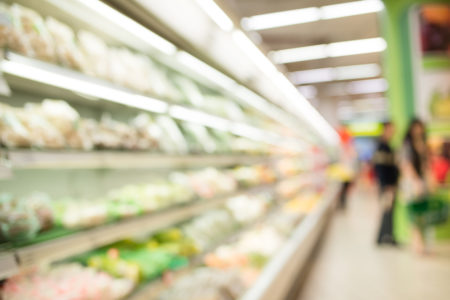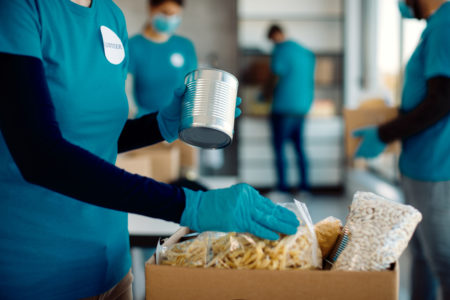Share On Social!
Food insecurity is impacting Latinos across the US, which includes the children of families who are struggling financially due to the spread of COVID-19.
While civic leaders throughout the country need to provide greater support to these individuals, some organizations are stepping up.
This includes the Children’s Hospital of Philadelphia (CHOP) who recently announced a new location of its Healthy Weight Food Pharmacy — a neighborhood-focused resource that provides families healthy food.
“Because food insecurity intersects with other social determinants of health, the Food Pharmacy team also screens patients for co-existing social needs and connects them to appropriate resources,” said Alonzo South, Senior Director of Community Engagement at CHOP. “We know that many of our families report having housing issues, difficulty paying their utility bills, and transportation challenges. These experiences reinforce that our families are dealing with competing needs that make it difficult to prioritize healthy living.”
Fighting Food Insecurity with Food Pharmacies?
Food insecurity is being without reliable access to a sufficient quantity of nutritious food.
For families who have either used their last funds to buy food or are facing living with food, insecurity can apply to receive food from the food pharmacy.
“In order to determine their eligibility for the program, patients will be screened for food insecurity during the check-in process at select well visits,” CHOP writes in a recent news release. “Families that identify as food-insecure will then receive a three-day supply of dry food to help address their immediate food needs. After the initial supply of dry food, families will receive a box of fresh produce once a month for up to 6 months to address ongoing needs.”
Once approved, they will receive a three-day supply of nutritious food that includes:
This kind of support is critically needed, according to Dr. Saba Khan, the Medical Director of the CHOP Food Pharmacy.
“For our initial experiences, we know that food insecurity and other important social determinants of health, like housing and mental health support, affect many more families than those we see in the Healthy Weight Program,” Khan said in a recent statement. “The COVID-19 pandemic has exacerbated the problem of food insecurity and introduced it to many more families in West Philadelphia. This is one way we can help our neighbors get the support they need to have healthy, fulfilling lives.
“We estimate that the new Food Pharmacy program will enroll up to 300 unique families in the first year, with a goal to reach about 1,000 people with this program.”
More than that, they help families in the long term, too.
This kind of support includes connecting those facing food insecurity to resources that include: Enrollment in benefit programs, like Supplemental Nutrition Assistance Program (SNAP) and Women, Infants, and Children (WIC); local food pantries; community food resources; and other social services.
SNAP is especially critical in helping families who are experiencing food insecurity. Latinos make up about 20% of SNAP recipients.
“In a time of economic uncertainty, increasing SNAP benefits is a proven policy approach to stimulate the economy, reduce economic hardship, and improve health,” according to a recent report from Healthy Eating Research.
Food Insecurity, Its Impact Among Latinos, and the COVID-19 Pandemic
Before the pandemic, “14.3 million American households were food insecure with limited or uncertain access to enough food,” according to Feed America.
This is especially impacting Latino and Black households, who are more likely to suffer food insecurity (16.2% and 21.2%, respectively) than the national average (11.1%), according to USDA data, Salud America! reports.
While it might take years to understand the impacts fully COVID-19 had on food insecurity, the initial findings aren’t looking good, according to Feeding America’s recent “The Impact of the Coronavirus on Food Insecurity” report. 
“The Coronavirus (COVID-19) pandemic is impacting vulnerable households in various ways. Many food-insecure individuals have characteristics that put them at a higher risk for severe illness associated with COVID-19,” Feeding America states. “Workers who have service occupations or work in the leisure and hospitality industry are more likely to be food insecure and are at risk of further hardship as many businesses have been forced to close and lay off staff.”
This makes the work CHOP is doing so critical.
“Since first becoming involved with the Healthy Weight Food Pharmacy program in 2019, we’ve seen firsthand the powerful impact it is having in the community,” Nicholas Bertram, President, The GIANT Company, told Yahoo! News. “As a company passionate about changing children’s lives and eliminating hunger, helping to expand access to this life-changing program to families in additional neighborhoods in Philadelphia is something we’re glad to be able to do.”
What You Can Do
Food insecurity is harming families where you live.
Leaders are stepping up to help, like Philadelphia’s food pharmacy, Atlanta’s food forest, and New York’s plans to help grocery stores donate excess food to charity.
You can help, too.
By downloading a Health Equity Report Card by Salud America! at UT Health San Antonio, you can see how many local children are living in poverty and food deserts, how many people have low food access, and how many households get access to SNAP food benefits.
Then you can email your Health Equity Report Card to community leaders, share it on social media, and use it to make the case to address food insecurity where help is needed most!
Get your health equity Report Card!
Explore More:
Healthy FoodBy The Numbers
1
Supermarket
for every Latino neighborhood, compared to 3 for every non-Latino neighborhood




